Jof's World Tour: Back across the Channel
- Jul 14, 2023
- 10 min read
Trip miles so far 8,270
By Jon Newey
On leaving my ABnB in Stuttgart, Garmin has a bit of a dickie-fit and takes me right through the centre of the city during the morning rush hour. So it is that I get to visit the Staatsgallerie anyway (at least I ride slowly past it).
The Staatsgallerie feels a bit like an old friend. I was here in 1984 when it first opened, driving a VW campervan around Europe. In 1984 the USSR and the Berlin Wall were both still part of Europe’s reality and that’s partly the reason that my current tour has concentrated on all the eastern EU countries, these being places that I couldn’t visit forty-odd years ago. The Staatsgallerie’s modern extension was designed by a British Architect, Jim Stirling, who sadly passed away in 1992 not long after it was completed.
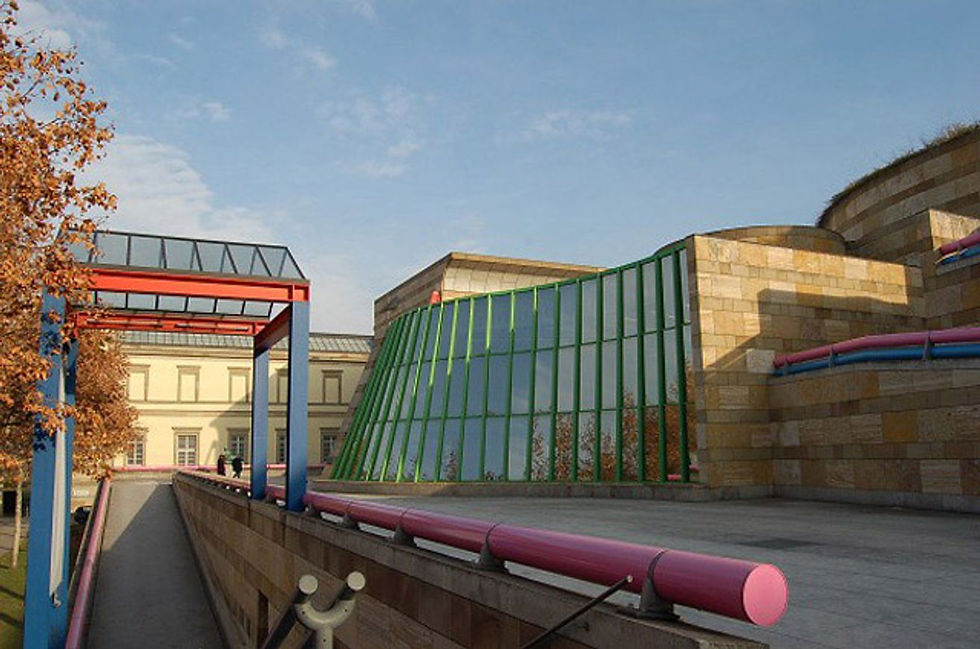
One of the UK’s biggest annual prizes in Architecture – the Stirling prize - is named in Jim’s honour. As I crawl past the gallery in Stuttgart’s early morning traffic it is good to see that it is unchanged, still the exuberant post-modern style and pastel pinks and blues that I remember.
From Stuttgart we’re doing autobahns again all day today. Now that I’m back in western Europe it feels like I am almost home and I’m less inclined to take the slow roads. The autobahn takes Tigger and I across southern Germany until we reach the Rhine. The border between Germany and France is in the centre of the river. These days this is another border that is non-active, so we swoop across the bridges and voila, we're in France. That makes country number 21 for me (20 for Tigger). At last! A country where I can do a passable job of speaking the local lingo…
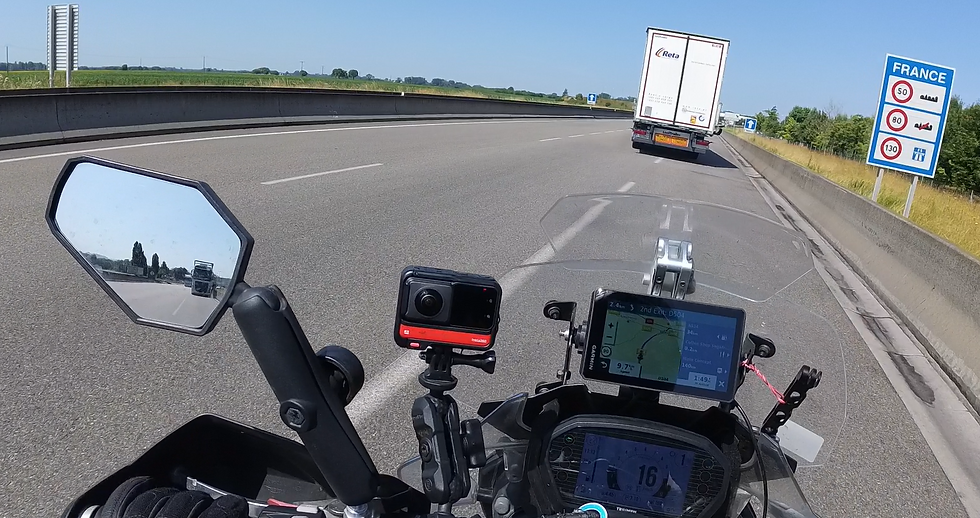
Two hours later we’ve arrived at Verdun where there’s a leafy campsite with its own bar, restaurant and pool. Zut alors! The French understand what a campsite is supposed to be like! No sooner have I arrived and pitched my tent than I’m greeted by Mattius, a German biker on a Royal Enfield Himalayan. He wanders across with two beers, one for me and one for himself. He’s mid 60’s, a truck driver and ex-army. He comes here regularly to explore the battlefields, he says. We wander up to the restaurant and eat burgers together but I can’t quite keep pace with his beer tally… I have to be sober tomorrow to ride to Calais! And then we meet up with Eric and Martin, two more German bikers who are on their way to Brittany. Martin rides an old Suzuki GS1200 and Eric is on an equally old Moto Guzzi California. They are not camping, they have a cabin with a veranda. Luxury. The four of us sit on the veranda and spend a pleasant polylingual evening setting the world to rights. German politics is a hot topic, particularly the growing differences between east Germany and west Germany, a fault-line that has never quite healed, it seems.
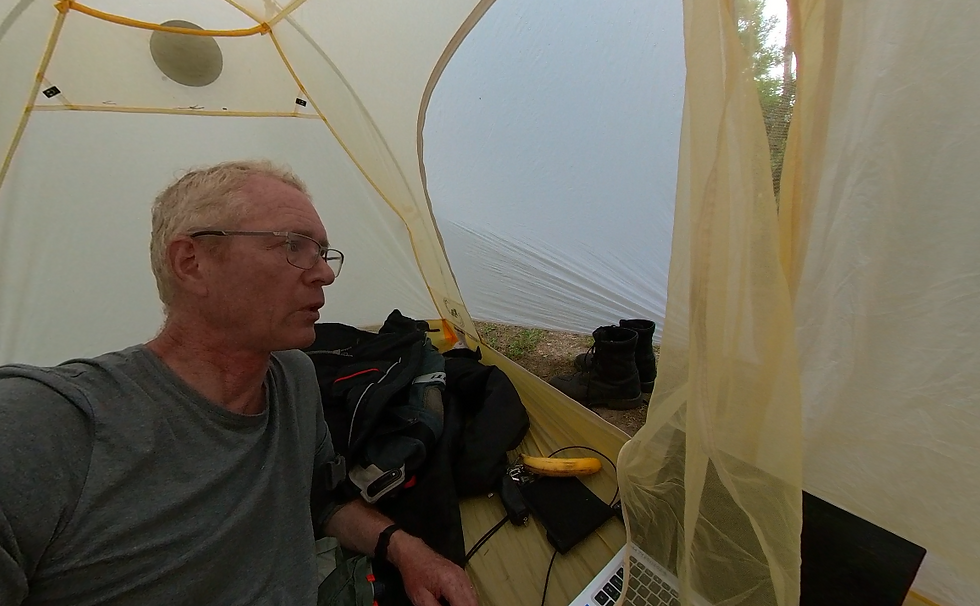
I love sleeping in my tent. I always sleep well and wake up feeling refreshed. I wake early though, as soon as it is light. There had been some talk yesterday evening of us four bikers sharing breakfast today but by the time I’ve packed my tent away there’s still no sign of Mattius (I suspect the evening went on for some time after I bowed out) and Martin is only just emerging from his cabin. So I scoff a couple of croissants, slurp a double espresso, wave goodbye and off I go.
Western Europe has a great motorway network. So good that it is hard to avoid it. My target for today is a motel-type hotel in Calais. Garmin takes me straight onto the ‘paeage’ system where I sit on the cruise control for a couple of hours. Toll stations are a frequent annoyance. The toll fees here are a lot more expensive than they were on the toll roads in Greece and within a couple of hours my pocket is 20 Euros lighter than it started out!
I have detours planned, of course – you know me by now! Today’s detours all relate to the fact that I’m riding through northern France, the battlegrounds of the first world war. My Grandfather fought in the battle of the Somme and survived (obviously, or I wouldn’t be here) so I can’t ride through this area without trying to learn a little more about it.
My first port of call is the town of Peronne, on the east bank of the Somme river, where there is a museum all about WW1. The museum itself is interesting, a very slick modern intervention designed into the remains of a medieval castle in the centre of the town. The castle was badly damaged during the war and this re-working of the building is very neatly done. The exhibits are fascinating too.
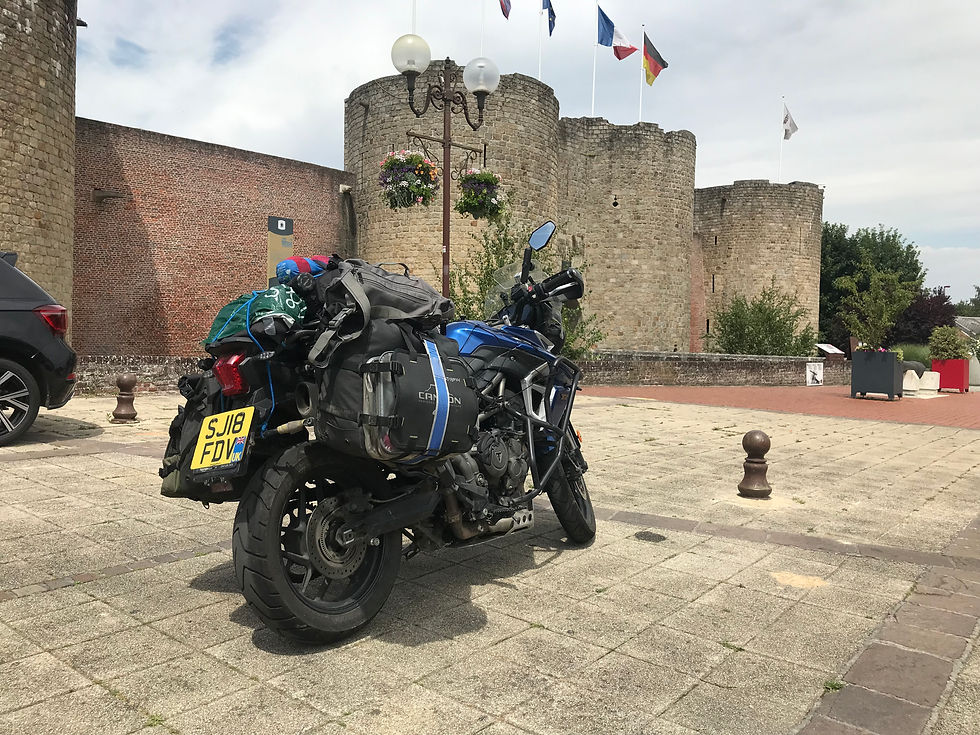
Me being me, I find that the most fascinating exhibits are in the collection of paintings and drawings that were created by soldiers in the trenches. The collection is extensive, some on display and the rest kept in drawers in cabinets that visitors are invited to explore for themselves. Somehow these drawings and paintings are more moving and more personal than the grainy black and white photos in the rest of the exhibition. They are in colour too. Most of the paintings have the artist’s name on them and I find myself wondering about their personal stories. Did they survive the war? How did the paintings survive? Did they paint other things before the war and after the war was over? There’s a larger exhibition of the work of Otto Dix, a well-known German impressionist artist who survived the trenches but then spent years afterwards creating some very disturbing artworks in an effort to expunge his recollections. This was such an interesting museum for me in so many ways.
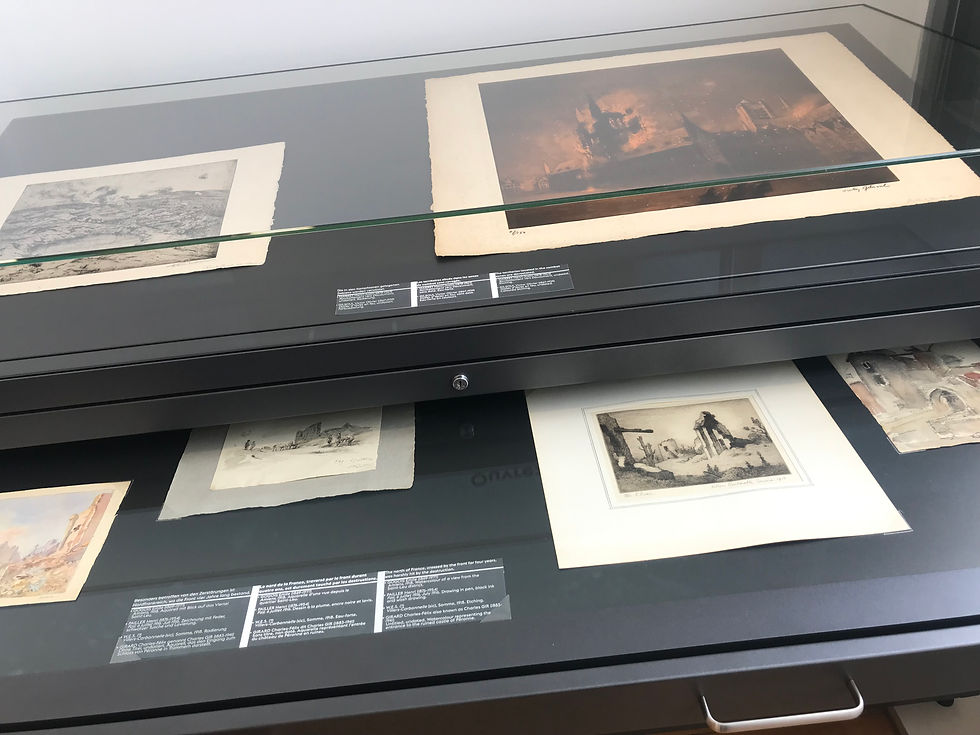
I emerge blinking back in the daylight outside. It is 29 degrees C. It is market day in Peronne so some roads are closed and others are crowded. I weave Tigger through the narrow streets and head towards my second port of call for the day, the memorial monument at Thiepval (pronounced T-hiepval in France). Thiepval isn’t far from Peronne. The countryside has rolling hills, fields of wheat and avenues of trees, with a few poppies growing here and there. The road is straight. Every few hundred metres there’s a brown sign saying ‘Front line, November 1914’ and ‘Front line June 1915’ and ‘Front line September 1917’. The signs are distressingly close together.
At Thiepval I park, I ignore the visitor centre and walk towards the monument. It was designed by Sir Edwin Lutyens in 1932. There’s a relatively small cemetery alongside with 600 war graves. This monument, however, is all about the soldiers for whom there is no grave. Carved into the walls are the names of 72,337 French and British men who have never been found. The monument is huge, very peaceful and quite moving.

I move on. Back on the ‘peage’ roads Tigger and I dodge from one toll station to the next and we’re soon approaching Calais. I have a room booked in a travel-lodge-motel-type-thing for the night. It is comfortable enough and all I really need is somewhere to sleep before my ferry crossing the following morning. There’s a bar/grill opposite where I grab some food. A beer here costs me more than a whole evening’s food and drink has been costing me in Eastern Europe. In general the Eurozone has been proving to be roughly twice the price of the countries not using the Euro, based on the exchange rate of those currencies relative to the British Pound.
Next morning in the car park I’m packing Tigger when I meet up with Nick, a BMW GS1200 rider from Newcastle. He’s been riding some off-road tracks in Switzerland and France for the last two weeks and is heading for home on the same ferry as me. We ride over to the ferry port together. At passport control there’s a ten-minute queue which causes lots of tutting and tooting from the impatient British drivers. Compared to the 5-hour wait I had at the Turkey-Greece border this is a breeze .... The Border control officer checks my passport, clocks all the recent in-out border stamps, nods appreciatively at Tigger, tells me he's very jealous and lets me straight through.
I’ve never been to the Calais ferry terminal before. I am amazed at how big the port is. There are hundreds of numbered lanes and you have to make sure you get into the right lane to get yourself onto the right ferry. I’m directed to lane 1,124… I’m more used to Newcastle ferry port where there are no more than half a dozen lanes and there’s only one ferry so you can’t get it wrong. Nick and I park our bikes and head into the terminal for a coffee. We sit and swap stories back and forth until suddenly we realise all the cars have gone and our two bikes are all alone on the dockside! Quick! We don’t want to miss the ferry! We dash down the stairs and pull on our helmets and gloves, but the lady directing traffic doesn’t let us move. ‘You were meant to be on ze ferry first’ she says in her French accent ‘but now you will be ze last!’ and she waves a few trucks and camper-vans forward.
A girl on a bicycle joins us. She’s French and she lives in Cambridge. She’s been visiting a friend in Calais. ‘Oh, I don’t ride the bicycle’ she says ‘but this ferry doesn’t allow foot passengers, they only let you on if you have a vehicle, so I had to bring the bicycle with me. I’ll be taking the train back to Cambridge’.
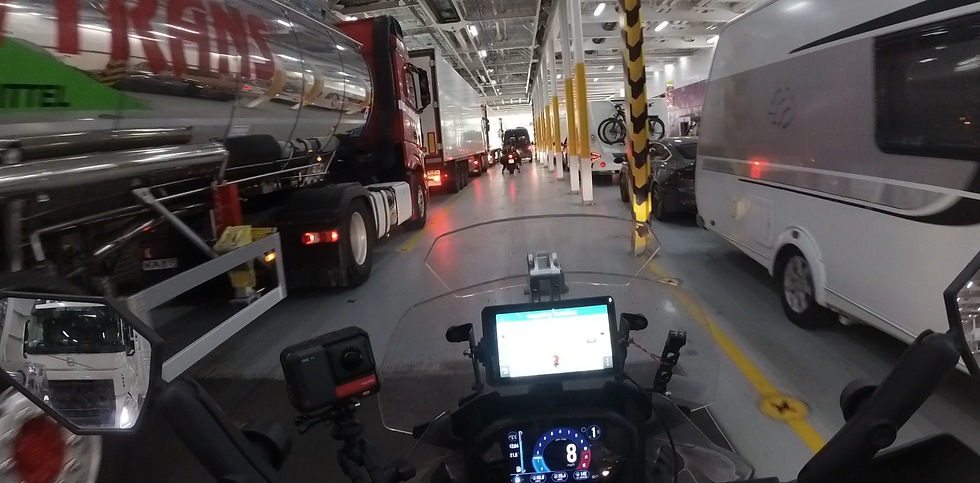
We ride onto the ferry and we park with all the other bikes – the ones who were all loaded first. Ha! The crossing is just 90 minutes so we sit upstairs and chat some more and before we know it the white cliffs of Dover are going past the window. Back down on the car deck I realise that my sat-nav has gone missing. It was in my jacket pocket. Perhaps it fell out. I head back up the stairs squeezing past all the people coming down and I hunt around at the table where Nick and I were sitting. Suddenly one of the ferry’s staff spots me and says ‘Are you looking for your GPS?’ Yes, I am. He’s already found it and has put it safely behind the bar. Great! Back down on the car deck I’m just in time to start Tigger up and filter through to the front of the queue with all the other bikes. Nick’s heading off straight up to Newcastle but I’m only going as far as my sister’s house tonight, so we wave a salute and head off in different directions.
It is cold and it is raining (welcome back to the UK, Jon) and I have to concentrate to remember to ride on the left side of the road. I have to remember to go clockwise round roundabouts. I’ve switched Tigger’s dash back to miles but forgot to switch the sat-nav so it is still reading in kilometres. The combined effect of all this together with the wet roads and the sudden density of the UK’s traffic makes my brain hurt so I stop to sort out the GPS and to wait for the rain to stop before carrying on.
Before long I’m back at my sister’s house. The next day I head up to Lincolnshire and after that I’m back up the A1, onto the A68, through Jedburgh and back to Edinburgh. Arriving home I check the odometer. It shows Tigger has clocked up 8,270 miles on this tour.

Trip summary:
Miles on this trip 8,270 miles (=13,232 km)
Number of countries visited: 20 for Tigger, 21 for me.
Highest altitude reached: 2,504m (=8,215 feet) on the Grossglockner pass, Austria
Second highest altitude reached: 2,145m (=7,037 feet) on the Transalpina pass, Romania
Hottest temperature recorded: 42.5 degrees C (=109 F) at the Turkey-Greece border
Coldest temperature recorded: 3 degrees C (=37.5 F) in Scotland on day two, with ice on Tigger’s saddle.
Different currencies used: 9
Longest bridge crossed: 4 km (=2.5 miles) over the Dardanelles Strait, Turkey
Longest tunnel: 5.8km (=3.6 miles), Mala Kapela Tunnel, Croatia.
Nights under canvas: 5 (I received emergency alerts on my phone for bad weather in all the best camping territory!)
Nights in Bunk-a-Biker: 1 (tried several others but none were available)
Nights in AirBnB: 22
Nights in hostel dorms: 13
Nights in hotels: 6
Ferry crossings: 6
Stopped by Police: 1
Bears spotted 0
Wolves spotted: 0
Boars spotted: 0
Tortoises spotted: 1 (It was trying to cross a dual carriageway, I had to swerve to miss it…)
Snakes spotted: 2 (sunning themselves on the hot tarmac near Motocamp in Bulgaria)
Stray dogs spotted: >1000
Tigers spotted: 7 (three 900’s, three 1200’s and Tigger, of course, who is an 800)
Tigger repairs: Kickstand spring came loose. One oil change. Front indicator stalk broken
Kit failures/repairs: Exhaust burnt through one bungee. Stretchy cargo nets only lasted 5 weeks. Zips broke on cheap luggage. Broken arm on my glasses repaired with Araldite.
Jon repairs: Nothing other than insect bites (two requiring treatment).
Memories created: Uncountable!
Conclusion:
So, what have I learned? I’m ashamed to say that before I started this trip my ignorance about eastern Europe was almost total. I consider myself a well-educated and well-traveled man, but six months ago I could not have correctly identified Slovakia, Romania, Bulgaria, Montenegro or Slovenia on a map. Now I can. I wasn’t too sure about Poland or Croatia either…. Of the 20 European countries Tigger and I visited I didn’t know which were in the EU, or which of them were in the Schengen area. I didn’t know which of them use the Euro, or what other currencies they might use. I didn’t know whether these countries were mountainous or flat, what languages they spoke, what religions they followed or what food to expect.
It feels good now to have put some flesh onto the bones of my scanty knowledge and to have gained some understanding, however briefly, of all these countries – our European neighbours - countries that most of us in the UK only ever hear about in sporting competitions or in Eurovision.
I didn’t get to Georgia, which is a shame. I also didn’t see Serbia or Bosnia. These are all still on my bucket list. I also didn’t get to up to see the north east Baltic states of Estonia, Lithuania and Latvia. That’s a trip for another day which might include a ferry crossing to Finland. And I didn’t go into Ukraine or Russia, obviously. One day, maybe?
Arriving home I see news reports that southern Europe is now in the grip of an extreme heatwave called Cerberus, with temperatures predicted to get even hotter than those I experienced in Turkey. I think my decision to turn back at Assos in mid June and head north is probably justified. The highest temperature recorded in Europe to date is 48.8 degrees in Sicily in 2021. The news reports are expecting that record to be broken. Imagine trying to ride in 50 degrees C in helmet and leathers.... I think it might have killed me.
So what next? The ‘stans’ and the silk road are on my mind. I might look for a pre-arranged tour for that, though (sorry Tigger, you can sit that one out). Crossing Canada from Nova Scotia to Alaska is still in the mix, of course. I’m also quite taken with the idea of using the ferry from Ireland to Bilbao and then riding the length of Portugal to get the ferry across to Africa. I could head for Dakar and then back to Paris, perhaps? And maybe get a beer in a bar in Casablanca on the way (of all the bars in all the world…)? Where’s the southernmost bar in Europe? Where’s the westernmost bar in Africa? So many possibilities. I’ll need a few weeks to decide…..

Jon
.jpg)



Comments